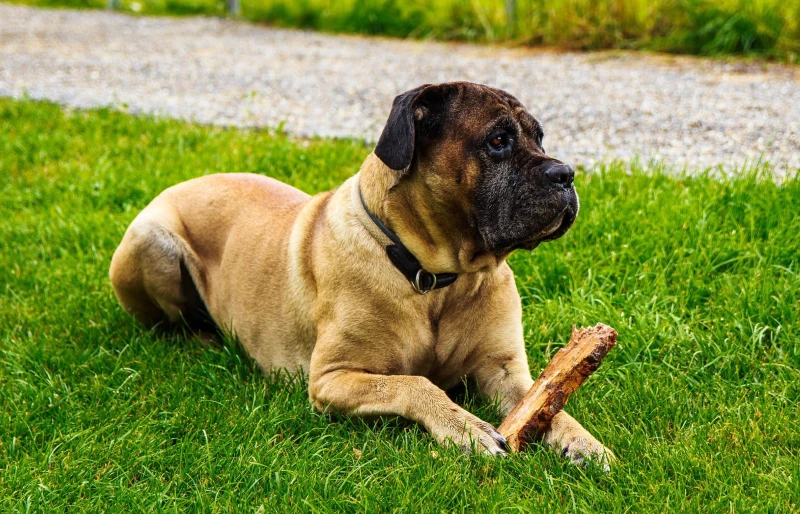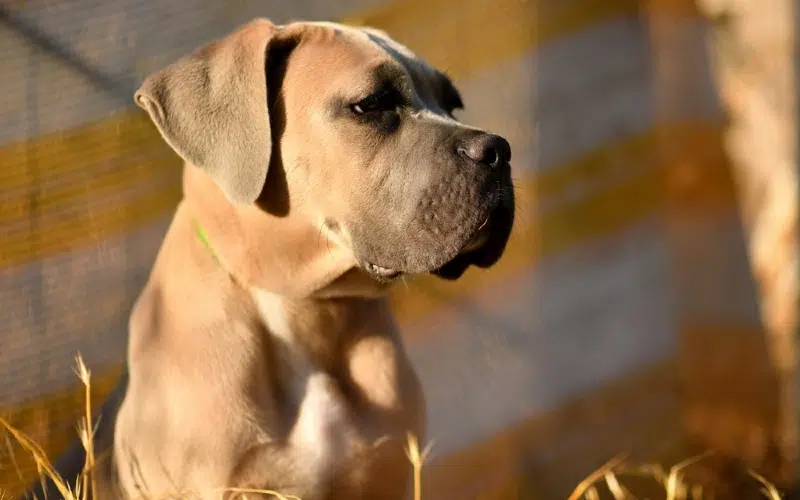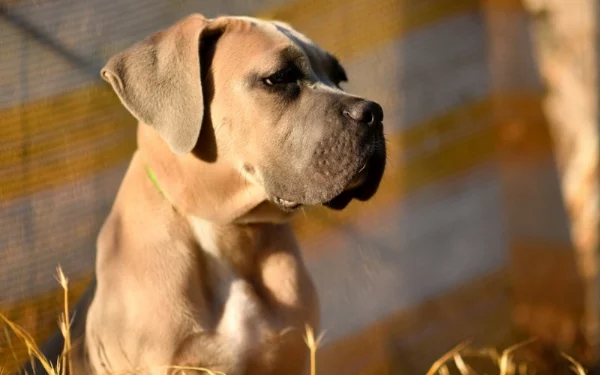Click to Skip Ahead
The Cane Corso is an intelligent, noble-bearing, assertive, and trainable dog. Ideal for families in search of a fearless protector, the Cane Corso has a long history of serving as a guard dog. Today, the breed is recognized in seven colors, with fawn and black being the most popular.
Breed Overview
Height:
23 to 26 inches
Weight:
100 to 1120 pounds
Lifespan:
9 to 12 years
Colors:
Black, fawn, gray, gray brindle, red, black brindle, and chestnut brindle
Suitable for:
Active families looking for protective and playful dogs
Temperament:
Intelligent, loyal, and eager to please
Standing roughly 25 inches tall and weighing over 100 pounds, it’s clear that the Cane Corso was bred for protection. Fawn Cane Corsi are one of the seven recognized variations of the breed, which may be seen with a black or gray mask.
Although Cane Corsi are famously seen in their black coats, the fawn Cane Corso is equally as protective, loyal, intelligent, and alert. Keep reading to learn more about fawn Cane Corso’s characteristics, origin, formal recognition, facts, and temperament.
The Fawn Cane Corso Breed Characteristics
The Earliest Records of Fawn Cane Corso in History
The Cane Corso breed originates from a subcategory of working dogs known as the molossus breed or molossers. These dogs were named after the Molossia, a group of ancient Greek people who bred Mastiff-type guardian dogs with giant and big-boned bodies.
After subduing and occupying the Greek islands at the prime of the Roman Empire, the legions brought the molossus breed back to Italy. Here, they bred these dogs with native Italian breeds, creating the first ancestors of the modern Cane Corso.
The offspring of these crossbreeds also created the Neapolitan Mastiff. Initially, Cane Corsi were used as war dogs, earning their stripes as “pireferi.” This fearless breed charged the enemy lines carrying buckets of flaming oil on their backs.
In its origins, the Cane Corso was bigger and more lumbering compared to the sleeker Cane Corso of today, which has a feline-like grace.

How Fawn Cane Corsi Gained Popularity
As the Western Empire dissolved in the 5th century, there was no more work for the Italian legions and dogs, including the Cane Corso. Soon, Cane Corsi adapted to civilian jobs like guarding farmsteads or hen houses, livestock driving, farming, and wild boar hunting.
A Cane Corso on the Italian countryside’s farms and pastures was no rare sight. However, the Italian peninsula and Sicily were under constant invasions, leading to economic and political upheavals.
As a result of mechanized farming, the Cane Corso population reduced exponentially. The breed was nearly extinct as the mid-20th century arrived. Luckily, a group of Italian Cane Corso fanatics in the 70s worked to rescue the breed of their ancestors.
For this purpose, they founded the Society Amorati Cane Corso (Society of Cane Corso Lovers) in the 1980s and began exhibiting the Cane Corso at European dog shows. By 1988, the first Cane Corso arrived in the US to be recognized by the AKC in 2010.
Formal Recognition of Fawn Cane Corso
The Cane Corso has many accounts of formal recognition. First, it was recognized by the Ente Nazionale della Cinofilia Italiana in 1994, while the Fédération Cynologique Internationale provisionally accepted the breed in 1996.
Finally, the breed was entirely accepted in 2007 before the American Kennel Club of the United States recognized it in 2010. Today, 3,000 to 4,500 Cane Corsi are registered in Italy every year.
Fawn is one of the seven recognized colors of the Cane Corso breed. Other colors include Black, Gray, Gray Brindle, Red, Black Brindle, and Chestnut Brindle.
Top 5 Unique Facts About Fawn Cane Corso
Here are five unique facts you may not know about the fawn Cane Corso:
1. The Fawn Cane Corso Almost Went Extinct
The Cane Corso was used as a war dog during the Second World War, drastically reducing this breed’s population. From the 40s to the 60s, the need for hunting and farming dogs also decreased, which is why the Cane Corso was no longer bred.
A group advocating for the Cane Corso breed in the 70s rescued the few remnants and revived the breed by showing them at European dog shows. As a result, Cane Corsi were imported to America in the 80s.
This occurred after a Neopolitan Mastiff enthusiast traveling to Sicily saw a Cane Corso herding cattle at an Italian farm. Fascinated by the breed, the enthusiast asked the owner to import the first Cane Corso to America.
2. The AKC Has Strict Rules for the Fawn Cane Corso Mask
Before you get a fawn Cane Corso, make sure to learn about the requirements surrounding its facial mask. A recognized fawn color has a dark, smoky black patch on its muzzle and inner eye.
If the mask goes past the eye, it indicates that the Cane Corso is not purebred. However, Cane Corso puppies are not part of this rule as they may have a black saddle and mask covering a larger area than seen in the AKC standard.
These markings typically fade as the pup grows older. If it doesn’t, the dog may not be purebred.
3. The Rare Formentino Cane Corso Has a Diluted Fawn Gene
Translating to “fermented wheat” in Italian, Formentino describes a light golden-tan variation of Cane Corsi. These rare dogs do not have the standard black mask but a gray or blue mask on their noses.
When both parents have a diluted fawn gene, the resultant Cane Corso puppy is considered a Formentino. Having diluted fawn genes is regarded as a recessive trait in Cane Corsi. These recessive characteristics are typically hidden due to dominant features, which is why it’s incredibly rare to find Formentino Cane Corsi.
If you want to guarantee the birth of a Formentino puppy, it’s best to crossbreed two Formentino Cane Corsi. As a result, the diluted fawn gene will be ensured, resulting in a beautiful and rare Formentino Cane Corso.
You may also cross a Formentino Cane Corso with a Fawn Cane Corso containing the diluted gene, but that will leave a 25% chance for the puppy to be Formentino. Crossing two fawn Cane Corsi results in a 50% chance of having Formentino puppies.

4. The Fawn Is One of the Seven Recognized Colors for a Cane Corso
The American Kennel Club has strict breed standards regarding the coat and mask color of purebred Cane Corsi. For this breed, only seven colors are officially recognized by the AKC. These include:
- Black
- Fawn
- Gray
- Gray Brindle
- Red
- Black Brindle
- Chestnut Brindle
Cane Corsi of all colors may have white markings on the back of their feet, toes, throat, chin, and chest. Markings in other areas indicate that the Cane Corso may not be purebred. Chestnut brindle, black brindle, and gray brindle Cane Corsi may have striped coats and fawn pigmentation, which is beautiful and rare.
If you find a black and tan Cane Corso, it’s worth noting that this variation is not recognized by the AKC, as it may have been bred with a Tibetan Mastiff or Doberman.
5. Tri-Colored Cane Corsi Are a Variation of Fawn Cane Corsi
Tri-colored Cane Corsi have white spots, a black mask, and a beautiful fawn coat, making them a variation of the fawn Cane Corso. This may occur due to white markings cropping up in the litter, adding a charming variety to the typically solid-colored Cane Corso.
Luckily, this variation is recognized by the AKC breed standard. Other than that, red Cane Corsi also have tri-color variations with black masks.
Does a Fawn Cane Corso Make a Good Pet?
Yes, the Cane Corso makes an excellent pet if you’re looking for a dominant breed to serve as a watchdog. Aside from being protective, these dogs also make great companions due to their unwavering loyalty.
If you have young children, your Cane Corso will definitely enjoy watching over them. Since these dogs instinctively take charge, you’ll need to establish your role as the leader early on. This will allow you to consistently control its behavior.
It’s also crucial for pet owners to train and socialize their Cane Corso at a very young age to maintain their dominant nature. When left untrained, these dogs can become aggressive toward other pets and people. You may begin training them as young as eight weeks old.
Since Cane Corsi can be pretty large, they’re best suited for families with older children. Its reserved, confident, and territorial nature keeps it alert to its surroundings, making it the ideal guard dog.

Conclusion
The Cane Corso has a rich history dating back to the 5th century when it was initially bred as a war and guard dog. After almost going extinct in the 1900s, the breed was revived by a group of enthusiasts in the 70s, leading to their formal recognition in 2010.
Today, Cane Corsi are known for their calm and collected temperament while still staying loyal and protective of their families. These dogs are ideal for active families with older children looking for a playful guard dog.
See Also:
- Blue Brindle Cane Corso: Facts, Origin & History (With Pictures)
- American Cane Corso vs Italian Cane Corso: How Are They Different? (With Pictures)
Featured Image Credit: Natalia Fesiun, Shutterstock











